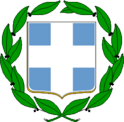|
|
Periphery:Peloponnese Prefectures : Arcadia , Argolis , Corinth, Laconia, Messinia
The Peloponnese as seen from space
The Peloponnese (Greek Πελοπόννησος, Peloponnesos; Latinized as Peloponnesus, and principally known in English as the Peloponnese) is a large peninsula in southern Greece, forming the part of the country south of the Gulf of Corinth. Geography The Peloponnese covers an area of some 21,549 km² (8,320 square miles). It constitutes the southernmost part of mainland Greece, although technically it is an island since the construction of the Corinth Canal in 1893. It has two land connections with the rest of Greece, a natural one at the Isthmus of Corinth and an artificial one in the shape of the Rio-Antirio bridge (completed 2004). The peninsula has a mountainous interior and deeply indented coasts, with Mount Killíni its highest point at 2,376 m (7,795 ft). It possesses four south-pointing peninsulas, Messenia, the Mani Peninsula, Epidaurus, and the Argolid in the far northeast of the Peloponnese. Two groups of islands lie off the Peloponnesan coast: the Argo-Saronic Islands to the east, and the Ionian Islands to the west. The island of Kythira, off the Epidaurus peninsula to the south of the Peloponnese, is considered to be part of the Ionian Islands. History The peninsula has been inhabited since prehistoric times. Its modern name derives from ancient Greek mythology , specifically the legend of the hero Pelops who was said to have conquered the entire region. The name Peloponnesos means "Island of Pelops". During the Middle Ages, the peninsula was known as the Morea. According to folk etymology, this is because the Crusaders found it densely planted with mulberry trees (Greek: moreai) used by the flourishing silk industry.
Greece's first major civilization, the Aegean (or Mycenaean) civilization, dominated the Peloponnese in the Bronze Age from the stronghold at Mycenae in the north-east of the peninsula. During classical antiquity, the Peloponnese was at the heart of the affairs of ancient Greece, possessed some of its most powerful city-states and saw some of its bloodiest battles. It was the site of the cities of Sparta, Corinth, Argos and Megalopolis, as well being as the homeland of the Peloponnesian League. The peninsula was involved in the Persian Wars and was the scene of the Peloponnesian War of 431 BC-404 BC. It fell to the expanding Roman Republic in 146 BC and became the province of Achaea. The Peloponnese was subsequently ruled by the Byzantine Empire, though many parts were lost to invading Venetians and Franks. The Franks founded the Principality of Achaea in the northern half of the penisula in 1205, while the Venetians founded a number of ports around the coast such as Monemvasia, Pylos and Koroní which lasted into the 15th century. The Byzantines retained control of the southern part of the peninsula, which they ruled from the fortified hill town of Mystras near Sparta. They staged a revival from the mid-13th century through to the mid-15th century, when the Ottoman Turks overran the Peloponnese between 1458-1460. The Venetians occupied parts of the peninsula between 1699-1718 but Turkish control was otherwise solid and opposed only by sporadic rebellions in the Mani Peninsula, the southernmost part of the Peloponnese.
The Peloponneseans played a major role in the Greek War of Independence – the war actually began in the Peloponnese, when rebels took control of Kalamata on March 21, 1831. The decisive naval Battle of Navarino was fought off Pylos on the west coast of the Peloponnese, and the city of Náfplio on the east coast became the seat of independent Greece's first parliament.
Image from the year 1909 During the 19th and 20th century, the region became a relatively poor backwater and a significant part of its population left, heading for the cities, especially Athens, and other countries such as the United States and Australia. It was badly affected by the Second World War and Greek Civil War, experiencing some of the worst atrocities committed in Greece during those conflicts. Matters have improved somewhat since then, especially since Greece joined the European Union in 1981 and tourism began to take off. However, the Peloponnese is still one of the poorer parts of the country. It is renowned for being one of the most traditionalist and conservative regions of Greece and is a stronghold of the right-wing New Democracy party.
2007 Greek forest fires, Peloponnes and Euboea
Cities The principle modern cities of the Peloponnese are ([2001] census): Archaeological sites The Peloponnese possesses many important archaeological sites dating from the Bronze Age through to the Middle Ages. Among the most notable are: Epidaurus (ancient religious and healing centre) Political organisation
Though "Peloponnese" is used to refer to the entire peninsula, the periphery with that name includes only part of that landmass. The Peloponnese is a periphery of Greece, consisting of 5 prefectures (Greek: νόμοι):
Arcadia The prefectures of Achaea and Ilia are also part of the peninsula, but are part of the West Greece periphery. A small part of the peninsula belongs to the "mainland" periphery of Attica.
Links
Retrieved from "http://en.wikipedia.org"
 |
|
|||||||||||||||||||||||||||||||
|
|









